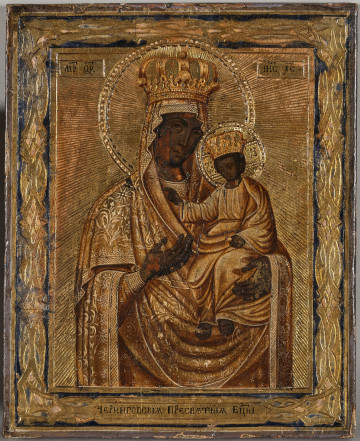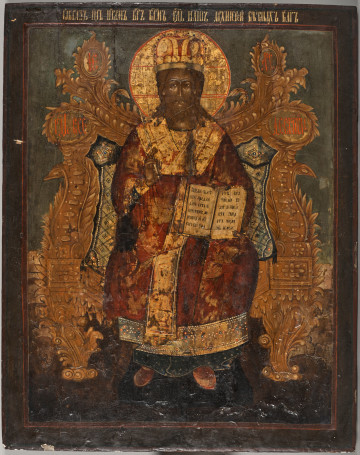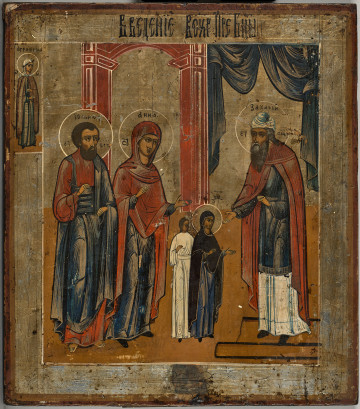
The Mother of God of Hodigitria
19th (?) century
Castle Museum in Łańcut
Part of the collection: Ikony
The displayed icon is a depiction of Christ's face - a Mandylion. The icon, called 'Acheiropoietos' in Greek ('not created with human hands') and in Rus 'Spas Nierukotwornyj', belongs to a particular type of paintings. The cult of the Mandylion proliferated in Byzantium and spread to Rus. It is described in source and apocryphal texts. The bishop Eusebius of Caesarea, who lived in the 3rd/4th c., cited the story of the king of Edessa, Abgar V Ukkāmā the Black from the Osroene dynasty. Christ sent a miraculous imprint of his face on a piece of cloth to the mortally ill ruler in Edessa. Thanks to deep faith and this supernatural gift, the king recovered. During the period of reverting to paganism, the Mandylion was hidden inside a wall by the Christians. Discovered by the bishop Eulalius during the siege of Edessa by the troops of Khosrau in 554, the image not only duplicated itself on the ceramic tile which had been covering it but also caused the retreat of the Persians. The tenth-century "Story of the Image of Edessa" relates several versions of the story. Emperor Romanos Lekapenos secured the image by promising to depart from Muslim Edessa; subsequently, the image was reverentially brought to Constantinople on the 15th of August 944 and placed in the Pharos chapel. The Mandylion was regarded as the most important relic, on par with the wood of the True Cross, but it disappeared in 1204 during the Fourth Crusade when the Crusaders captured and looted Constantinople. By that time, many copies had been created. The cloth with the Saviour's face imprinted on it only appeared on the depictions of Acheiropoietos in the 12th c. and was creased in the 13th-14th c. Since the 15th c., the draped cloth of the Mandylion is frequently held up and revered by two Archangels. The Latin equivalent of Acheiropoietos is the Veil of Veronica - "Vera Icon" - with the depiction of Christ's face imprinted on a towel during the Path to Crucifixion, along with traces of blood and marks of the crown of thorns. Teresa Bagińska-Żurawska https://orcid.org/0000-0002-9243-3967
Dimensions
height: 6.2 cm, width: 5.3 cm
Object type
Icons
Technique
cast
Material
bronze
Origin / acquisition method
decyzja administracyjna
Creation time / dating
Creation / finding place
Owner
Castle Museum in Łańcut
Identification number
Location / status

19th (?) century
Castle Museum in Łańcut

1800 — 1850
Castle Museum in Łańcut

1800 — 1899
Castle Museum in Łańcut
DISCOVER this TOPIC
Museum of King Jan III's Palace at Wilanów
DISCOVER this PATH
Educational path